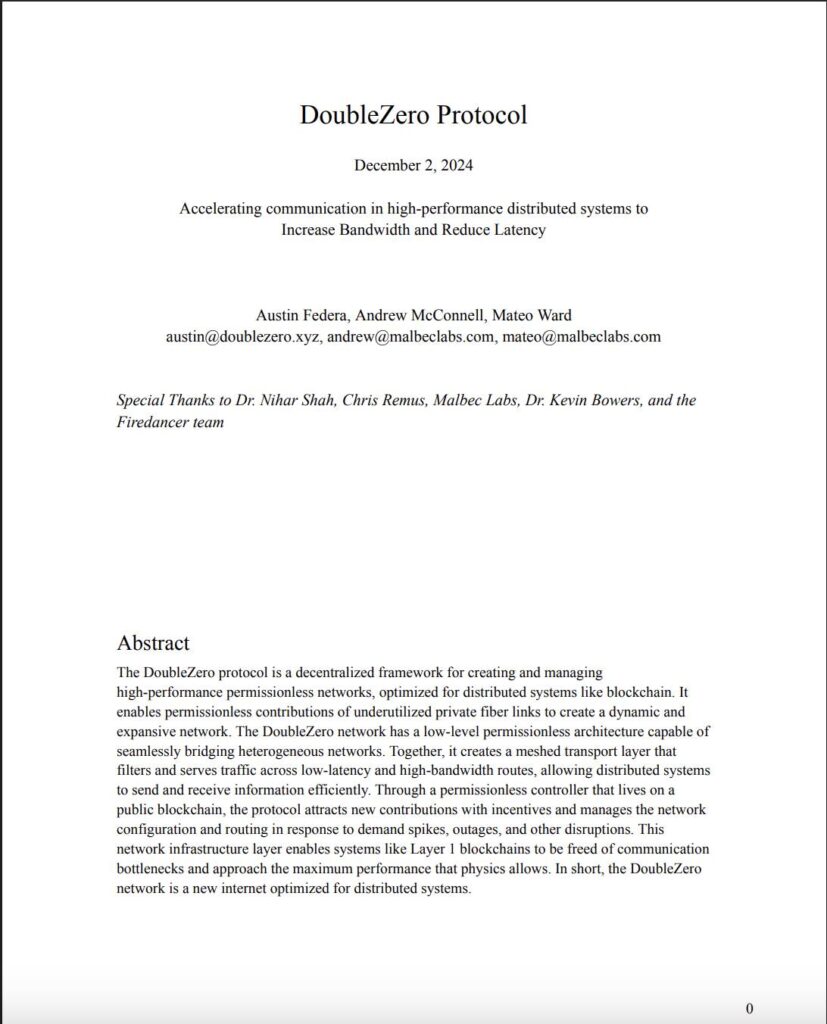The world of cryptocurrency continues to evolve, and a recent interview with Austin Federa, co-founder and CEO of DoubleZero, highlights a significant challenge that could be hindering the growth of blockchain technology. Speaking at Consensus 2025 in Toronto, Federa emphasized that the public internet infrastructure is a major bottleneck for high-throughput blockchain networks, which have been increasingly demanding in terms of speed and performance.
“The downside of the public internet is it was never built for high-performance systems,” Federa explained. He noted that the traditional structure of internet communication was designed for simple server exchanges, not for the complex needs of blockchain validators scattered worldwide.
This insight sheds light on the limitations posed by existing internet technologies when it comes to handling the large amounts of data generated by blockchain transactions. Instead of allowing for streamlined communication, current systems compel validators to function as heavy data broadcasters, which drastically affects performance. According to Federa, the public internet’s infrastructure is now the leading constraint on blockchain capabilities, surpassing even issues related to computational power or software advancements.
DoubleZero aims to change this landscape by developing high-speed fiber optic communication rails designed specifically for blockchain use. The potential impact of these new networks could be profound, leading to faster transaction speeds, reduced fees in decentralized finance (DeFi), and the unlocking of new use cases that have been previously stymied by inadequate communication infrastructure.
Founded in December 2024, DoubleZero has embarked on an ambitious project with a focus on diminishing latency and expanding bandwidth. Following a successful capital raise of $28 million, the company is on track to launch its public mainnet in the latter half of 2025. The recent token sale, exclusively available to accredited investors and current validators across several high-throughput environments, indicates a strong interest in enhancing blockchain performance from within the community.
“As the industry continues to grow, so does the need for dedicated communication infrastructure,” Federa stated, underscoring the urgency for innovative solutions as blockchain technology becomes more sophisticated.
With efforts underway to tackle the infrastructure hurdles facing the blockchain realm, projects like DoubleZero signal a promising shift towards achieving the performance levels required for a thriving decentralized ecosystem. The quest for high-speed, reliable communication methods illustrates the dynamic nature of the cryptocurrency landscape and its continuous push toward innovation.
Public Internet Infrastructure and Blockchain Performance
According to Austin Federa, co-founder and CEO of DoubleZero, public internet infrastructure is a significant constraint on high-throughput blockchain networks. Here are the key points related to this topic:
- Public Internet Limitations:
- The public internet was not designed for high-performance systems.
- It is structured for interaction between large and small servers, not for massive data broadcasting.
- Impact on Blockchain Operations:
- Validators must manage significant data consumption and broadcasting, requiring substantial resources.
- The main constraint on blockchain performance is now the public internet infrastructure, not compute power or software development.
- Enhancements through DoubleZero:
- DoubleZero aims to improve blockchain speed and performance by deploying high-speed fiber optic communication rails.
- Their infrastructure will facilitate lower transaction fees and enhance decentralized finance (DeFi) trade efficiency.
- Improved communication infrastructure could unlock new blockchain use cases.
- Company Background and Development:
- Austin Federa founded DoubleZero in December 2024 after leaving the Solana Foundation.
- DoubleZero aims to reduce network latency and increase data bandwidth.
- The public mainnet launch is expected in late 2025, after raising $28 million in capital.
- Token Sale Insights:
- A validator token sale held in April 2025 targeted accredited investors and existing validators.
- This sale reflects growing interest and investment in blockchain infrastructure development.
DoubleZero: Revolutionizing Blockchain with High-Speed Fiber Optic Solutions
In a rapidly evolving blockchain landscape, the need for robust and efficient internet infrastructure is becoming increasingly crucial. Austin Federa, co-founder and CEO of DoubleZero, has pinpointed a significant challenge: the existing public internet infrastructure simply wasn’t designed to support the high-speed demands of modern blockchain networks. Unlike traditional setups where one big server communicates with smaller ones, blockchain validators require a system that can handle vast data throughput both in and out.
DoubleZero stands out in the marketplace by addressing the latency and bandwidth constraints that plague current blockchain implementations. This transformative project aims to deliver high-speed fiber optic communication rails specifically tailored for high-throughput networks. What sets DoubleZero apart is its potential to not only enhance speed but also to reduce transaction fees and improve the efficiency of decentralized finance (DeFi) trades. As the competition intensifies, this unique focus could provide DoubleZero with a significant edge over traditional blockchain solutions that are still tethered to outdated internet frameworks.
However, while DoubleZero is tapping into a crucial market need, there are inherent challenges and potential pitfalls. The reliance on accredited investors for their validator token sale could restrict community involvement, potentially alienating smaller stakeholders who may wish to participate in blockchain validation. Moreover, the ambitious timeline for launching their mainnet in the latter half of 2025 may be optimistic in the fast-paced tech environment.
DoubleZero’s innovations could greatly benefit developers and businesses seeking to leverage high-performance blockchain capabilities without the bottlenecks currently faced on the public internet. Yet, these improvements may pose a problem for legacy systems and existing blockchain projects that have to adapt swiftly to maintain competitiveness. As the demand for high-speed solutions increases, those unable to pivot might find their relevance diminished in a world that increasingly values speed and efficiency.

















